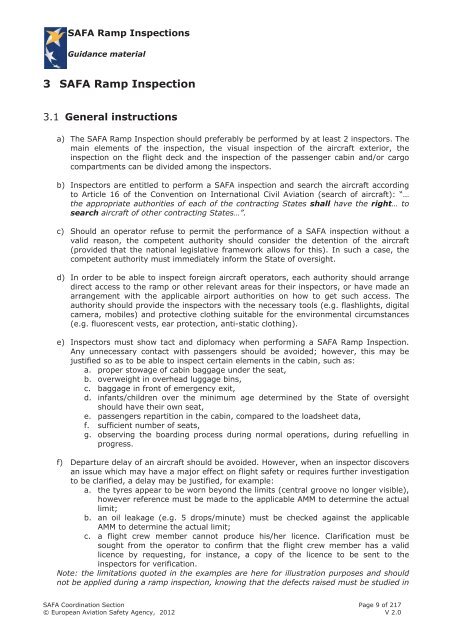SAFA Ramp Inspections - Code7700
SAFA Ramp Inspections - Code7700
SAFA Ramp Inspections - Code7700
Create successful ePaper yourself
Turn your PDF publications into a flip-book with our unique Google optimized e-Paper software.
<strong>SAFA</strong> <strong>Ramp</strong> <strong>Inspections</strong>Guidance material3 <strong>SAFA</strong> <strong>Ramp</strong> Inspection3.1 General instructionsa) The <strong>SAFA</strong> <strong>Ramp</strong> Inspection should preferably be performed by at least 2 inspectors. Themain elements of the inspection, the visual inspection of the aircraft exterior, theinspection on the flight deck and the inspection of the passenger cabin and/or cargocompartments can be divided among the inspectors.b) Inspectors are entitled to perform a <strong>SAFA</strong> inspection and search the aircraft accordingto Article 16 of the Convention on International Civil Aviation (search of aircraft): “…the appropriate authorities of each of the contracting States shall have the right… tosearch aircraft of other contracting States…”.c) Should an operator refuse to permit the performance of a <strong>SAFA</strong> inspection without avalid reason, the competent authority should consider the detention of the aircraft(provided that the national legislative framework allows for this). In such a case, thecompetent authority must immediately inform the State of oversight.d) In order to be able to inspect foreign aircraft operators, each authority should arrangedirect access to the ramp or other relevant areas for their inspectors, or have made anarrangement with the applicable airport authorities on how to get such access. Theauthority should provide the inspectors with the necessary tools (e.g. flashlights, digitalcamera, mobiles) and protective clothing suitable for the environmental circumstances(e.g. fluorescent vests, ear protection, anti-static clothing).e) Inspectors must show tact and diplomacy when performing a <strong>SAFA</strong> <strong>Ramp</strong> Inspection.Any unnecessary contact with passengers should be avoided; however, this may bejustified so as to be able to inspect certain elements in the cabin, such as:a. proper stowage of cabin baggage under the seat,b. overweight in overhead luggage bins,c. baggage in front of emergency exit,d. infants/children over the minimum age determined by the State of oversightshould have their own seat,e. passengers repartition in the cabin, compared to the loadsheet data,f. sufficient number of seats,g. observing the boarding process during normal operations, during refuelling inprogress.f) Departure delay of an aircraft should be avoided. However, when an inspector discoversan issue which may have a major effect on flight safety or requires further investigationto be clarified, a delay may be justified, for example:a. the tyres appear to be worn beyond the limits (central groove no longer visible),however reference must be made to the applicable AMM to determine the actuallimit;b. an oil leakage (e.g. 5 drops/minute) must be checked against the applicableAMM to determine the actual limit;c. a flight crew member cannot produce his/her licence. Clarification must besought from the operator to confirm that the flight crew member has a validlicence by requesting, for instance, a copy of the licence to be sent to theinspectors for verification.Note: the limitations quoted in the examples are here for illustration purposes and shouldnot be applied during a ramp inspection, knowing that the defects raised must be studied in<strong>SAFA</strong> Coordination Section Page 9 of 217© European Aviation Safety Agency, 2012 V 2.0
















